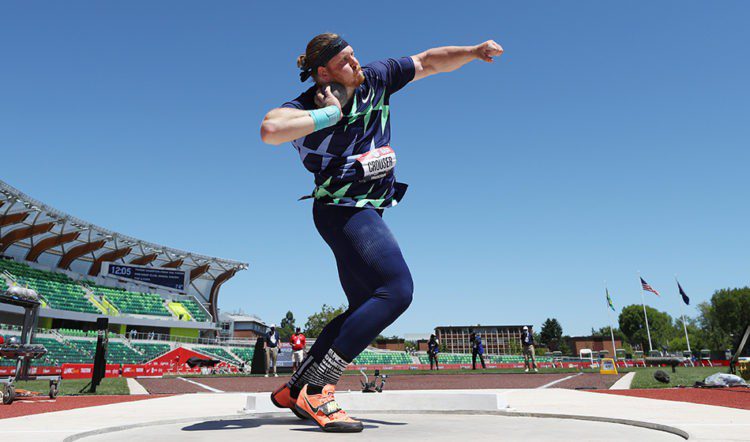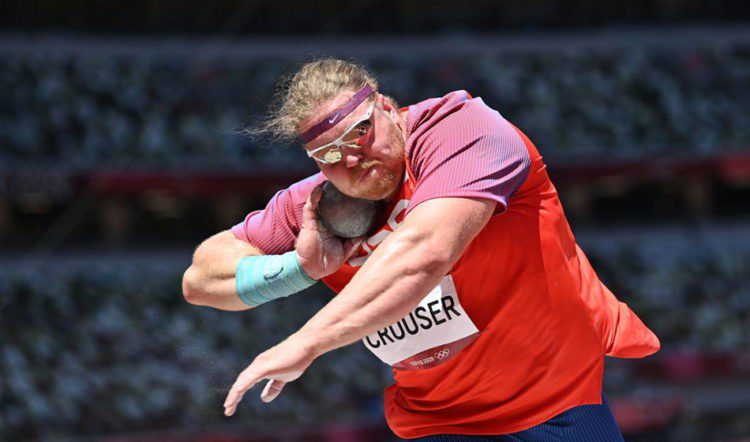The idea of seeing who can throw a heavy object over the greatest distance has been around for thousands of years. Homer mentions Greek soldiers having rock throwing competitions, while in the middle ages military men were known to hurl cannon balls.
It’s perhaps little surprise, then, that the shot put has been part of the modern Olympics since the first Games, in 1896.
Men throw a 16lbs (7.26kg) shot while the women compete with one weighing 8.5lbs (4kg). The shot is thrown from a circle with a diameter of 2.135m (seven feet) and a stop board 10cm (four inches) high at its front. The circle is normally made of concrete – or wood if it’s an indoor competition.
It’s an event with a very straightforward outcome but, as with so many sporting disciplines, mastering the nuance of technique is key. Few have ever been better at shot put than Olympic champion and world record-holder Ryan Crouser. AW sat down with him as he explained the discipline:
How would you explain shot put to someone who had never seen it?
I would say go to a bowling alley, pick up the heaviest bowling ball (16lbs) and go to a basketball court. Stand on the free throw line, turn around and try to make a three-quarter court shot with that bowling ball. If you did that you wouldn’t break the shot put world record but you’d be close to a medal at a major championships. I think that puts some perspective on what we’re doing out there.

Physical attributes
The best shot putters are really good athletes with a good sense of balance, are able to move well and are able to sprint. Having a good sense of rhythm is also important. If you have someone who’s fast moving in a straight line that isn’t enough because you have to be conscious of how you move rotationally as well.
It’s a misconception that it’s just about how much you can bench press. Being an all-round athlete and how you move is important.
Being on the bigger side, as far as build goes, helps. If you are skinny and built like a distance runner with narrow shoulders and a lighter bone frame, it’s hard to throw the shot a long way. But I would say that’s not a make or break because, when I was younger, I was tall and skinny. I would say it’s easier to get bigger and stronger than to develop natural athleticism.
Putting the shot
The rules state that the shot must start on the neck, finish near the neck and be released above the shoulder. It has to be more of a put movement, in close, which is biomechanically a much safer way to apply force. Think how much you can bench press compared to how heavy a ball you could throw.
You’re not allowed to drop below the shoulder or outside the shoulder as you would in a normal throwing motion, like you would throw a baseball or a cricket ball. I think that’s mainly to protect athletes starting out because you don’t want to be doing a throwing motion with a 16lb ball or you won’t have much of an elbow or shoulder left!

What constitutes a foul throw?
A throwing foul – when the ball comes below the shoulder, turning it into a throwing motion – is very unusual at the elite level. I don’t think I’ve ever seen an athlete called for a throwing foul. You have to throw, remain balanced and walk out of the back half of the circle.
Probably 99 per cent of fouls are when an athlete steps out of the front half, either accidentally stepping on the toe board or being off-balance. After a bad throw an athlete will often intentionally step out of the front because they don’t want their poor throw measured.
Two methods: glide or spin
Gliding is when you sort of shuffle from the back to the front of the circle, a very speed-orientated technique. The spin is where you do a full turn from the back to the front of the ring.
For the glide, which was the dominant style from the 1960s, you start with your back facing the toe board and make a single glide movement across, pushing off your right foot. You then land on the same foot before using your left foot in the power position and throwing the ball.
For a long time that was the textbook, prototypical, method. In the 1970s a few athletes started applying a discus-style rotational movement in the shot, with varied success. It’s a much more complex movement and it wasn’t until probably 2016 that the rotational method became dominant in major championships.
I have used both methods. I used the glide until I was 18 so I have a good understanding of, not my limits, but what the possibilities are because I threw with the glide and then switched to the spin. I think I could still have success with the glide but the upward potential of the spin is greater.
View this post on Instagram
Technique, speed or strength?
For me, at this stage, it’s a game of inches. The technical gains are the largest in terms of gaining distance. I would describe speed and strength as limiting factors. If you are not strong enough to be proficient through the movements, that can be detrimental and if you can’t go fast enough that can also be detrimental.
If you have a baseline speed and a baseline strength established, technique is then the optimising factor built on that basic speed and strength. I would advise any younger thrower to focus on technique. For me at the elite level, I still try to continue improving technique but also trying to raise my baseline.
Is height a help or a hindrance?
I am tall, which can be an advantage and a disadvantage. From a physics perspective, being tall can be an advantage because you have longer levers and therefore more time to apply force to the shot.
The downside of being tall is that, for me, the circle is very small – just over a foot shorter than the discus ring. That’s probably why you see more of the taller athletes throwing the discus rather than the shot.
Take Tomas Walsh or Joe Kovacs – they can be really dynamic across the ring. I can’t have a sprint dynamic technique – I have to have a technique which is very conservative, which is focused on how I keep my 6ft 7in self from fouling at the front of the circle. I’ve spent most of my career figuring out a technique that works for me.

Training
I do four throwing workouts a week during the off-season and will add another to go to five during the season and I do four or five lifting sessions during the week. In addition I will have sprints, plyometrics and medicine ball training mixed in.
Competition tactics
The normal format is three throws, then three more throws in reverse order. The thing to understand about throwing is that your best throw does not come when you’re going at 100 per cent effort, but rather in the 80 to 85 per cent range.
I’m trying but not trying absolutely as hard as I can and not trying to force it to happen. I am keeping the body relaxed, which makes technical execution easier and keeps you in the proper mental state. Its maximum effort but relaxed and letting the event happen.
There are some athletes who will skip, say, the fifth round to really focus on the sixth. Personally, I like to take all six throws although the effort might vary slightly between throws, depending on what the goal is for each round. In the first round I would probably throw at 75-80 per cent effort to get a mark in, to guarantee qualification for the last three throws. It’s what some people would call a safety throw.
After that I would increase intensity. So I might start with a throw at 75 per cent, then move up to 80-85 per cent for the next three throws. Then it’s about assessing if I can continue to push that and throw a little bit harder or am I already at a good level and just stick with the 85 per cent and just try to let a big throw happen?

It is beneficial to be ahead after three throws so that you are the last thrower in the last round. Before the last round if someone is ahead of me I know I will have at least one more attempt to better that.
It’s important to have the last throw in the last round – it means you’re the only athlete who has their fate in their own hands, because you know what you have to respond to.
I like being the last thrower. It either means that I know the competition is already won, which is a great feeling, but it’s probably the best feeling in shot putting to produce your best throw in the last round when you need it to win.
» This article first appeared in the January issue of AW magazine, which you can buy here
» New year special offer – get your first issue of AW magazine for just £1!
